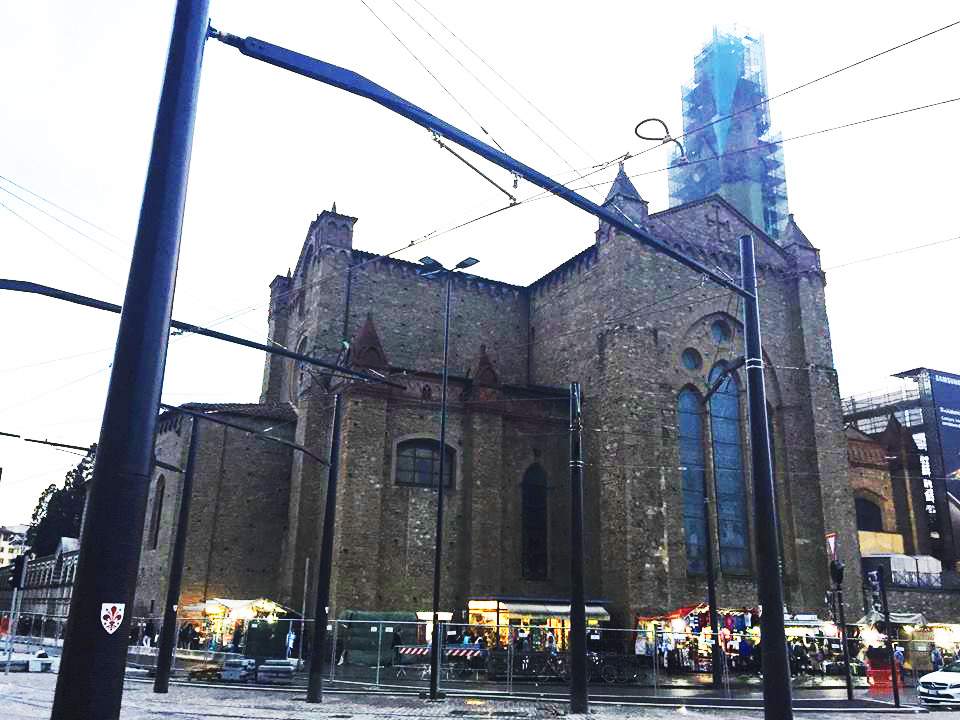There isheated controversy in Florence over the tramway works that are affecting Piazza della Stazione, in the portion between the apse of the basilica of Santa Maria Novella, one of the city’s most recognizable architectural masterpieces, and the train station of the same name, itself a masterpiece of Italian rationalism created by Giovanni Michelucci in the 1930s in a harmonious dialogue with the ancient urban context. Already last summer controversy had erupted over the cutting of the square’s pine trees, trees that still formed a small green island in the center of the Tuscan capital. Now it is the tramway poles, a veritable forest sprouting between the basilica and the Florence Santa Maria Novella station, that are now causing controversy, threatening, along with its tangle of cables, to compromise the square’s imagined twentieth-century layout and even disfigure the view of the sacred building.
“Not too many months have passed since, to the amazement of the Florentine citizenry, the cutting down of the historic pine trees in Piazza della Stazione, the last twentieth-century prospect of urban greenery well within the urban context created by the Tuscan Group of architects revolving around Michelucci in the 1930s,” Italia Nostra Firenze and the Coordinamento Cittadino Tutela delle Alberature wrote in a note. “After the deception, therefore the hoax. The hoax is precisely that metal ’forest of poles’ - as the newspapers have recently recalled - and that tangle of wires, which have these days materialized in the sight, not of the distracted tourists, but of the residents, those Florentines who know their city well and whose requests have never been taken into serious consideration (think of the unheeded Referendum on the Tramway ten years ago).”
Also very harsh was Superintendent Andrea Pessina who, reached by the newspaper La Nazione, spoke of a “very strong impact,” adding that the square project, if it had been presented under his tenure (the approval of the project in fact dates back to a time when Pessina was not yet superintendent in Florence), would not have received clearance. “I was worried immediately,” Pessina added, “about ten days ago when I saw that they were beginning to plant the poles: the effect it has now distresses me not a little.” However, any intervention now appears impossible: “You can’t undo work that has just been completed. Although I hope we will soon start a discussion table with the administration on this issue to be able to make at least some changes.” And for the future, Pessina hopes we can put our hands back on the project by lessening the impact of the poles: under study is the proposal for a battery-powered tramway in the section between Santa Maria Novella and the station. The idea is to combine the usefulness of the tramway project with the protection of the city’s beauty.
Criticism also comes from the political world. Silvia Noferi, group leader in the city council of the 5 Star Movement, reiterates that her party had long ago remarked on the need to power the battery-operated tramway in the sections where it would be most impactful, considers the silence of Unesco and representatives in the city serious, and launches into an accusation against the Democratic Party that it would “forever change the face of Florence, disfiguring entire neighborhoods, without the slightest sensitivity to the valuable historical-architectural context in which it was working to find a solution to mobility and pollution when there were simpler and less costly solutions.” Of “incalculable damage to the urban and architectural heritage of Florence” speaks instead of “incalculable damage to the urban and architectural heritage of Florence” speaks the vice-president of the regional council of Tuscany, Marco Stella, who is also the Florentine coordinator of Forza Italia, and who pointed out that it was possible to devise a battery or wireless system with power from below, as happens in other cities. On the other hand, Sergio Givone, a philosopher and former city councillor for culture of the City of Florence, pointed out that “beauty has been obscured” and hoped that soon the square could be freed from this cumbersome presence again.
On the opposite side of the barricade, Public Works Councillor Stefano Giorgetti asked to wait until the end of the work to judge the outcome, and while specifying that he did not say “that the poles and contact lines are not invasive,” he wanted to point out, in a post on his Facebook page, “that others, before us, have assessed the impact deeming it adequate and giving the relevant approvals and authorizations.” Mayor Dario Nardella, responding to Italia Nostra’s criticism, also said that it would be better not to have the poles than to have them, but he defends himself by claiming that the project has been approved for years by all the relevant bodies.
Photo: Orlando Caponetto (via Facebook)
 |
| Florence, forest of tramway poles defaces Santa Maria Novella. Heavy criticism from associations and the superintendent |
Warning: the translation into English of the original Italian article was created using automatic tools. We undertake to review all articles, but we do not guarantee the total absence of inaccuracies in the translation due to the program. You can find the original by clicking on the ITA button. If you find any mistake,please contact us.